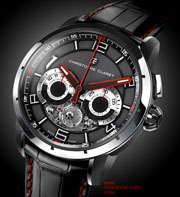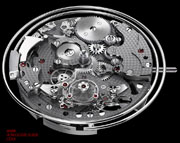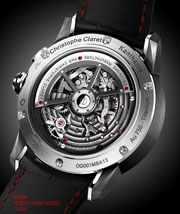

Christophe Claret
Nouveautés 2013 des montres Christophe Claret
Kantharos
 Son timbre cathédrale rugit à chaque changement de fonction du chronographe automatique, un concept inventé et développé par Christophe Claret pour la DualTow.
Son timbre cathédrale rugit à chaque changement de fonction du chronographe automatique, un concept inventé et développé par Christophe Claret pour la DualTow.
Elémentaire : un chronographe dont on entend le départ et l’arrêt avant de le lire à son poignet. Christophe Claret est parti d’un constat simple : les athlètes quittent les starting-blocks au coup de feu ; les boxeurs commencent et suspendent le combat au gong ; les chevaux s’élancent au signal du starter… Quoi de plus logique que de savoir très précisément, à l’oreille, quand démarre et quand stoppe le décompte ?
Kantharos intègre à la mesure des temps courts un système de sonnerie ingénieux qui se déclenche à chaque mode (start, stop, reset).
Nec plus ultra de la sonnerie, le timbre cathédrale visible à 10h, est doté d’un système breveté qui évite aux timbres de s’entrechoquer.
Le chronographe fait preuve d’une fiabilité et d’une performance hors pair. Son système d’embrayage à double flasques, inspiré des boîtes à vitesse dans l’automobile, permet d’éviter le saut de l’aiguille au démarrage du chronographe et ainsi d’augmenter la précision de la mesure.
Outre cette complication innovante, Kantharos s’offre une force constante. Pièce maîtresse, elle trône majestueusement côté cadran, à 6h. Ce savant mécanisme permet de diminuer sensiblement les écarts de marche de la montre. En effet, l’énergie délivrée à l’échappement est constant du début jusqu’à la fin de la réserve de marche.
Ingénieux à bien des égards, le calibre Kantharos, mouvement mécanique à remontage automatique, dispose des premiers composants fabriqués à base de M-15X. Ce nouveau matériau jamais encore utilisé pour réaliser de l’acier laminé en horlogerie et développé avec la société L. Klein SA, témoigne de l’attention particulière portée par Christophe Claret pour la recherche continuelle d’innovation, que ce soit en termes de complications horlogères, de machinerie ou de matériaux.
Acier issu de la métallurgie des poudres, une technique de fabrication lui garantissant une microstructure homogène et un grain extrêmement fin, le M-15X permet d’obtenir des terminaisons polies bloquées d’une qualité remarquable.
Logé dans un boîtier de titane et d’or blanc de 45 mm de diamètre, le mouvement a été conçu, développé et assemblé au sein de la manufacture.
 The automatic-winding chronograph's cathedral gong audibly chimes with each change of function – a concept invented and developed by Christophe Claret. Elementary: the starting and stopping of the chronograph is heard before the time is read off on the wrist.
The automatic-winding chronograph's cathedral gong audibly chimes with each change of function – a concept invented and developed by Christophe Claret. Elementary: the starting and stopping of the chronograph is heard before the time is read off on the wrist.
Christophe Claret started with a simple premise: athletes launch out of starting blocks when the gun is fired; boxers begin and stop their fights when a gong is struck; horses burst out of the stalls when the starter gives the signal.
So it is logical to hear exactly when the chronograph starts and stops timing. Kantharos enriches the world of short-time measurements with an ingenious striking system triggered by each change of mode (start, stop, reset).
The concept is entirely in line with Christophe Claret, which has repeatedly distinguished itself with innovative striking mechanisms featuring cathedral gongs.
The latter, the acknowledged king of chimes, is visible at 10 o’clock and equipped with a patented system that avoids the gongs vibrating against each other.
The chronograph delivers peerless and reliable performance. Its clutch disk system, inspired by car gearboxes, prevents the hand from jumping  when the chronograph starts to enhance precision.
when the chronograph starts to enhance precision.
This useful, functional and entertaining chronograph plays on the sensorial – acoustic and tactile – interaction between the instrument and its owner.
In addition to this innovative complication, Kantharos is also equipped with a constant-force escapement. Majestically enthroned on the dial side at 6 o’clock, this clever mechanism is a key component that considerably reduces timing variations.
The energy delivered to the escapement remains constant from beginning to end of the power reserve.
Precision is the overriding goal. The perpetually moving mechanism exercises a hypnotic visual effect, which may be admired beneath a meticulously chamfered sapphire bridge revealing the full extent of the master-watchmaker’s know-how.
The Kantharos caliber is ingenious in many respects. This self-winding mechanical movement is equipped with the first ever components made from M-15X. This new material has never been before used in the watch industry to make laminated steel and was developed in cooperation with L. Klein SA.
It epitomizes the particular attention Christophe Claret devotes to the constant pursuit of innovation – whether in terms of horological complications, machinery or materials. M-15X is a type of steel made using powder metallurgy-based production technology that gives it a homogeneous microstructure and a very fine grain. This material serves to achieve remarkably high-quality mirror-polished finishes.
Housed inside a 45 mm-diameter case in titanium and white gold, the movement was designed, developed and assembled in-house.
Soprano
Le mouvement est à remontage manuel, il tire son énergie d’un seul barillet, assurant à la montre une réserve de marche de quelque 72 heures, et associe dans une magnifique perspective deux des plus belles complications horlogères, le tourbillon et la répétition minutes.
 Le tourbillon 60 secondes (il accomplit un tour par minute) trône en majesté à 6 heures, soutenu par un pont étagé et ajouré de style Charles X.
Le tourbillon 60 secondes (il accomplit un tour par minute) trône en majesté à 6 heures, soutenu par un pont étagé et ajouré de style Charles X.
Il s’agit d’un classique de la Manufacture Claret, rompu à tous les tests de laboratoire depuis des années, dont le coeur bat à la fréquence de 3 Hz (21'600 alternances par heure).
Quant à la répétition minutes, c’est une complication qui permet, au moment de son déclenchement, de "lire" l'heure par l'intermédiaire de palpeurs et de cames puis de la restituer sous forme sonore, grâce à des marteaux venant frapper des timbres de différentes fréquences.
Celui de la Soprano a été développé au sein de la manufacture il y a plus de dix ans, mais revisité entièrement à cette occasion. Aujourd’hui, il se révèle encore plus complexe. Il répond au souci de Christophe Claret de toujours faire preuve d’innovation : « A mon sens, une nouvelle montre n’a d’intérêt que si l’on fait progresser nos recherches.
Avec la Soprano, nous avons cherché à obtenir la plus grande richesse musicale possible. Voilà pourquoi elle est capable de jouer les quatre notes du fameux carillon », explique le maître horloger du Locle.
Une complication supplémentaire qui suppose le montage de quatre timbres cathédrale et de quatre marteaux, visibles sur la face de la montre en raison de l’absence de cadran.
Construction voulue comme telle pour éviter tout obstacle inutile à la diffusion du son.
Quoique très compliquée à fabriquer et de taille relativement importante – elle affiche un diamètre de 45 millimètres et une épaisseur de 15,32 millimètres - la boîte de la Soprano se veut de facture classique.
 The minute repeater is considered – with good reason − to be one of the most demanding and difficult horological complications to realize due to the marriage of technical complexity with artistic musical tonality.
The minute repeater is considered – with good reason − to be one of the most demanding and difficult horological complications to realize due to the marriage of technical complexity with artistic musical tonality.
A minute repeater tells the time audibly with two notes created from two small hammers striking two gongs: one for the hours, one for the minutes and a combination of the two for the quarter hours. Even more complex is the Clarion repeater with three notes that can play a simple melody for the quarters.
However, the nec plus ultra of the minute repeater realm is the Westminster – so called for the distinctive tune played by the Big Ben clock at the Palace of Westminster, home of the British Parliament.
Big Ben strikes a complex melody for the quarters with four hammers striking four notes on four bells.
To provide an even fuller and richer sound than standard repeaters, the Christophe Claret Soprano features four cathedral gongs, each circling the perimeter of the movement twice (a normal gong goes around only once).
And to further ensure that the rich sound reaches the listen’s ears, the central case band is in grade 5 titanium, a metal known for its superior acoustic properties and used in musical instruments.
To minimize barriers to sound − and to maximize visual appreciation of the finely finished movement and the operation of the striking mechanism − the Soprano has no dial which allows the beautiful melody out and showcases the tourbillon, repeater operation, mainspring barrel, winding mechanism and Charles X bridges.
Eric Cosandey
©
toute reproduction strictement interdite
Tweet
On en parle sur le forum
La page de la marque